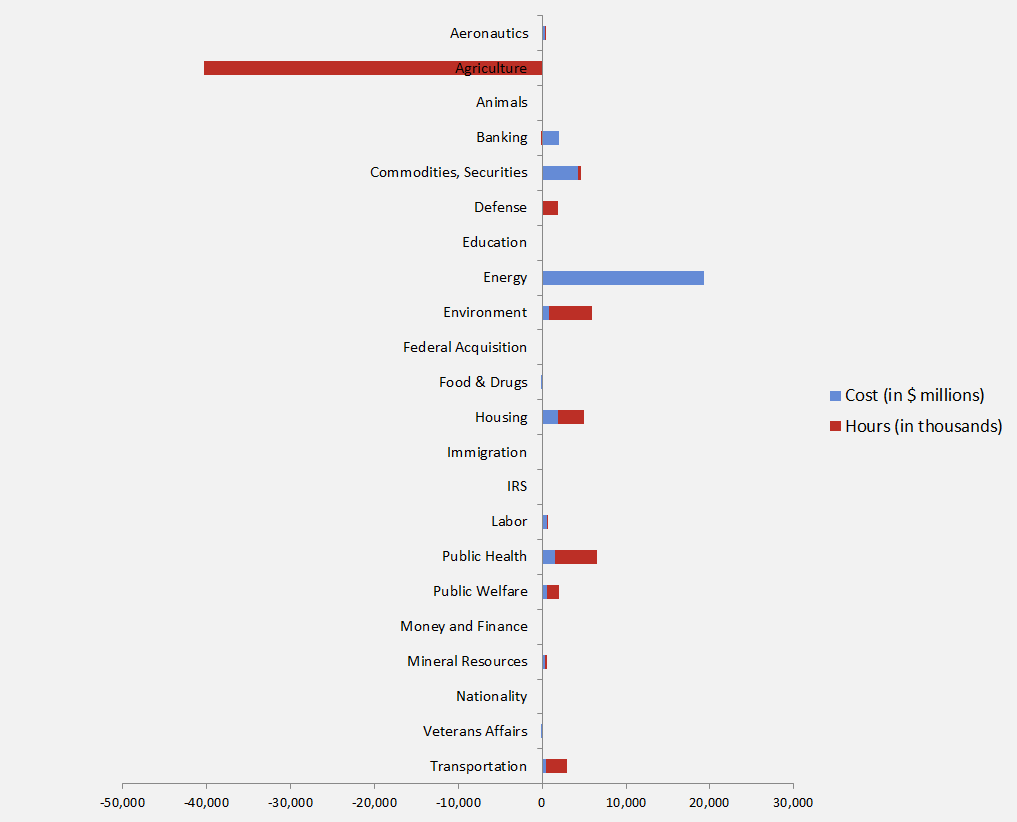Week in Regulation
July 3, 2017
Another Deregulatory Week
A trio of deregulatory proposals reduced total compliance costs this week by $9 million, with more than 177,000 fewer paperwork burden hours; agencies did not monetize potential benefits. Removing requirements for the shipyard industry, delaying a Department of Labor (DOL) rulemaking, and a Health and Human Services (HHS) paperwork reduction initiative led the week. The per capita regulatory burden for 2017 is $449.
Regulatory Toplines
- New Proposed Rules: 48
- New Final Rules: 108
- 2017 Total Pages of Regulation: 30,008
- 2017 Final Rules: $31.6 Billion
- 2017 Proposed Rules: $114.2 Billion
The American Action Forum (AAF) has catalogued regulations according to their codification in the Code of Federal Regulations (CFR). The CFR is organized into 50 titles, with each title corresponding to an industry or part of government. This snapshot of final rules (a change from earlier versions) will help to determine which sectors of the economy receive the highest number of regulatory actions.
The largest deregulatory action this week was a DOL proposal to revoke certain beryllium provisions for the construction and shipyard sectors. The permissible exposure limit would remain the same under the proposal. The agency estimates the amendment would save $11.5 million annually and cut nearly 50,000 paperwork burden hours.
DOL also proposed to delay its rule on tracking workplace injuries and illnesses, from July 1, 2017 to December 1, 2017. The original rule imposed $13.7 million in annual costs. The partial delay would save roughly $0.1 million.
HHS proposed a major rule that would qualify as a deregulatory action under Executive Order 13,771. The annual “Quality Payment Program” update would reduce roughly $7.5 million in annual burdens and eliminate more than 130,000 paperwork burden hours. Recall, in May, HHS proposed a rule with $60 million in additional costs, so this week’s action is just step one in offsetting the potential burdens of the previous major regulation, if the agency finalizes it.
This week, OIRA concluded review of four rulemakings, including a request for information for the “Fiduciary Rule,” a Medicaid eligibility rule, a revision to the “Waters of the U.S.” (WOTUS) rule, and changes to the end-stage renal disease program. Full repeal of WOTUS could save more than $450 million. In addition, OIRA also received prerules for the review of Nitrogen Dioxide standards and a request for information on last year’s “Overtime Rule.”
Tracking Regulatory Modernization
On regulatory budget implementation, below are the agencies that have accrued annual savings or new costs (assuming this EPA rule counts toward the budget) under the president’s one-in, two-out budget; proposed rules are not included:
- Defense: -$400 million
- Interior: -$360 million
- Education: -$100 million
- Labor: -$78 million
- Veterans Affairs: -$1.9 million
- HHS: -$0.02 million
- EPA: $60 million
Many of these figures are the result of CRA resolutions of disapproval. Given their historic regulatory output, AAF can predict that Defense, Interior, and Education will likely meet the goal of $0 in net regulatory costs by the end of this fiscal year.
Affordable Care Act
Since passage, based on total lifetime costs of the regulations, the Affordable Care Act has imposed costs of $53 billion in final state and private-sector burdens and 176.9 million annual paperwork hours.
Dodd-Frank
Click here to view the total estimated revised costs from Dodd-Frank; since passage, the legislation has produced more than 74.8 million final paperwork burden hours and imposed $38.5 billion in direct compliance costs.
Total Burdens
Since January 1, the federal government has published $145.9 billion in compliance costs ($31.6 billion in final rules) and has cut 18.6 million paperwork burden hours (due to 23.4 million in reductions from final rules). Click below for the latest Reg Rodeo findings.












